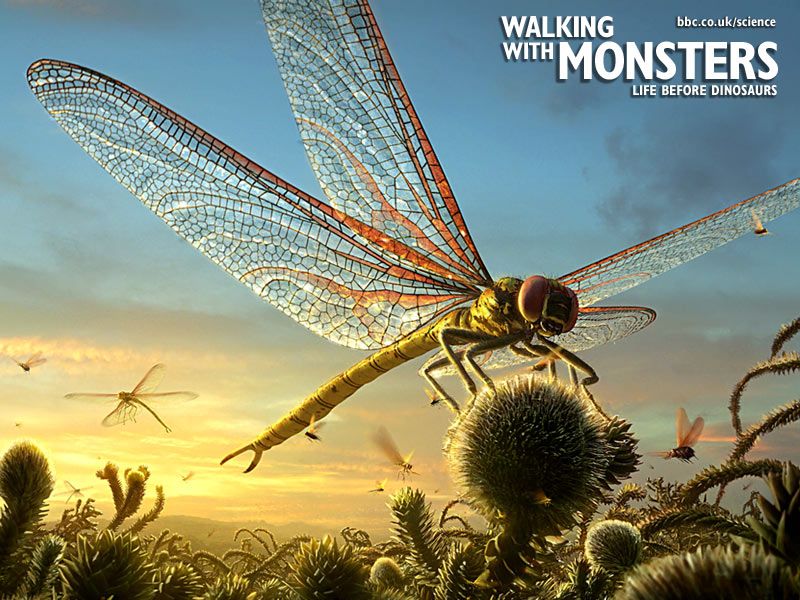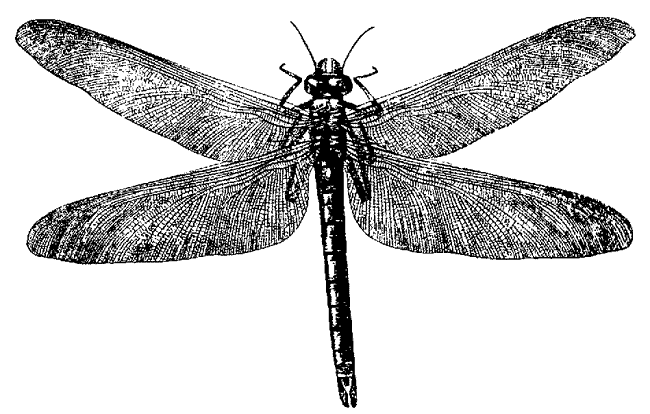
Meganeura as featured in the BBC science documentary Walking With Monsters
| Odonatoptera | ||
| Arthropoda | Meganisoptera |
| Diaphanopterodea | Arthropoda | Odonatoptera
└─► |
Odonata | |
| Ephemeroptera | None |
Neoptera |
|
Abbreviated Dendrogram
|
Contents
Overview |
Taxa on This Page
The Meganisoptera (commonly but incorrectly referred to as Protodonata [1]) or Griffenflies (Grimaldi & Engel) were a group of large to gigantic predatory flying insects, with wingspans of 12 to 75 cm. Like dragonflies, to which they were related, they had long narrow bodies, huge eyes, and strong jaws and spiny legs for grasping prey. The wing veination is extremely primitive, with all the main veins except one (the Rs vein) having separate origins at the base of the wing, and the cubito-anal area represented by a single vein. The characteristic structure of the true Odonata (dragonfly) wing are not developed. There was also a dense reticulation of cross-veins.
The Meganisoptera were closely related to true dragonflies (Odontata). Almost certainly the larvae were aquatic and carnivorous (like modern dragonfly larvae), and fed on small aquatic vertebrates (fish, and amphibia) or larger invertebrates. It is likely that the adults frequented open spaces where they had room to maneuver, and may well have spread to upland environments. Only a few families and genera are known; this appears to have been a small group, or alternatively to have frequented areas where they would not have easily fossilized.
 Meganeura as featured in the BBC science documentary Walking With Monsters |
Fossil remains of Meganisoptera are known from the late Carboniferous of France, the early Permian of North America, the late Permian of Russia and Australia. A single species recorded from the Triassic of France is most likely a true dragonfly. . It can be assumed that they evolved some time during the mid Carboniferous, flourished until the end of the Paleozoic. MAK020625 slightly revised 120517
Cladistic diagram - from Günter Bechly, Phylogenetic Systematics of the Odonates
Meganisoptera
Namurotypidae
Meganeuromorpha
Paralogidae (sedis mutabilis)
Kargalotypidae (sedis mutabilis)
Kohlwaldiidae (sedis mutabilis)
Meganeuridae (sedis mutabilis)
Carpentertypinae (sedis mutabilis)
"Tupinae" (sedis mutabilis)
Meganeurinae (sedis mutabilis) |
Note
[1] Although Protodonata is the term used in Grimaldi & Engel's definitive Evolution of the Insects, it is not technically correct. As Professor N.J. Kluge points out in his wonderfully titled Nomina Circumscribentia Insectorum database:
"Initially the family Protodonata Brongniart 1885 was established for a single genus Protagrion, while the genus Meganeura was placed to another family, named Sthenaropterida. Later (Lameere 1900, Handlirsch 1906-1908) added Meganeura and other insects, recently attributed to Meganisoptera, to the taxon Protodonata. Because Protagrion is no longer regarded to be close to Meganeura or even include din the Odonatoptera at all, but rather placed in the Protorrhynchota (Martynov 1932, Carpenter 1943, Bethoux & Nel 2003, et al.); the usage of the name Protodonata for the taxon which includes Meganeura and does not include Protagrion, contradicts to its original circumscription. The name Meganisoptera is therefore the preferred and widely accepted name for this taxon. The name Meganeuroptera Tillyard 1918 (from words "Meganeura" and "ptera") is older, but at the same time is peoccupied, because the same name Meganeuroptera Crampton 1916 (from words "mega" and "Neuroptera") was given for the taxon Corydalus/f1=Chauliodes/g1. The names Prototyloptera Crampton 1924 and Protaeshnoptera Crampton 1928 were given as synonyms of "Protodonata" in unknown sense, so they can be only presumably attributed to this taxon."
(slightly edited to clarify the English) MAK120522
 Meganuera monyi Brongniart, from the Latest Carboniferous (Stephanian Epoch (Upper Productive Coal Measures) Gzhelian age) Commentry (Allier), France. Graphic from Zittel & Eastman 1913 p.809, fig.1567. |
Meganisoptera Martynov 1932
Synonym: Protodonata Brongniart 1885 (invalid for this taxon)
Carboniferous (Bashkirian) to Late Permian
Phylogeny: Odonatoptera : Eugeropteridae + (Odonata + *)
Comments: large airborne diurnal predators, larvae (nymph) predatory, fed on small vertebrates, small fish, larval ("tadpole") and small adult amphibians, most likely frequented pond margins, lakes and watercourses, although adults could no doubt cover large distances and may have ranged wider afield
References: Karl Von Zittel's Text-Book of Paleontology ed. Charles R. Eastman, 2nd ed. vol.1 1937 MacMillan & Co. London; E. F. Reik, 1970, "Fossil History", in Insects of Australia, Melbourne University Press
Links: The magnificent, giant (and unfortunately extinct) griffenflies best on the web; Phylogenetic Systematics of basal Pterygota and Stem-Group Odonates - Günter Bechly,; Wikipedia; Meganeura Life reconstruction by Surface Vision; Meganeura Life reconstruction by Dinoraul, Meganeuropsis Life reconstruction by Karen Carr MAK120522
| Diaphanopterodea | Odonata |
page MAK020625; checked ATW050625, last modified MAK120522; Creative Commons Attribution;